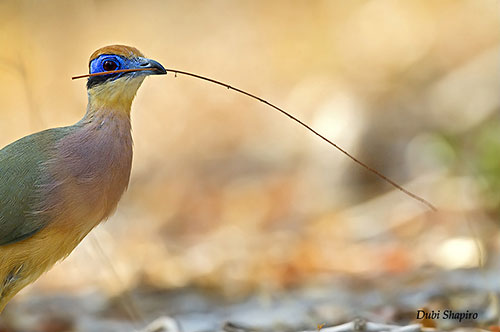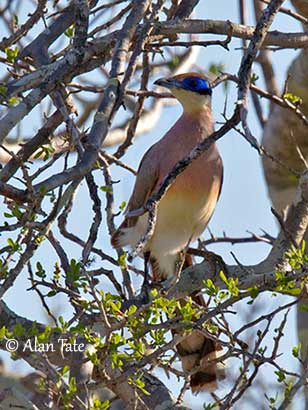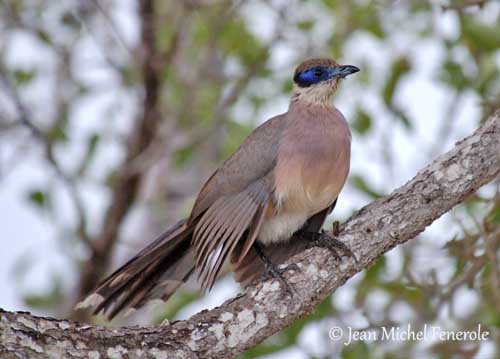
PROTECTION / THREATS / STATUS:
The Red-capped Coua is commonly hunted and could be affected by deforestation. However, it occurs in degraded woodland habitats and in several protected areas, making it probably reasonably secure.
Both races are common throughout the range and are not globally threatened.
The Red-capped Coua is currently evaluated as Least Concern.
Fr: Coua à tête rousse (ruficeps) – Coua à tête olive (olivaceiceps)
Ang: Red-capped Coua (ruficeps) – Olive-capped Coua (olivaceiceps)
All: Rostkappen-Seidenkuckuck
Esp: Cúa Capirrojo
Ita: Cua capirosso
Nd: Roestkopcoua
Sd: rödhättad koua
Mal: Akoky, Aliotse, Beloha, Gory
Photographers:
John Anderson
John Anderson Photo Galleries
Jean Michel Fenerole
Photos d’Oiseaux du monde
Dubi Shapiro
Dubi Shapiro Photo Galleries & Dubi Shapiro's Pictures on IBC
Alan & Ann Tate
AA Bird Photography
Text by Nicole Bouglouan
Sources:
HANDBOOK OF THE BIRDS OF THE WORLD vol 4 by Josep del Hoyo-Andrew Elliott-Jordi Sargatal - Lynx Edicions - ISBN: 8487334229
Cuckoos of the World Par Johannes Erritzøe, Clive F. Mann, Frederik Brammer, Richard A. Fuller – Editeurs A&C Black, 2012 – ISBN: 1408142678, 9781408142677
Birds of the Indian Ocean Islands Par Ian Sinclair, Olivier Langrand - ISBN: 1868729567, 9781868729562- Editeur: Struik, 2003
The Cuckoos Par Robert B. Payne – Editeur: OUP Oxford, 2005 – ISBN : 0191513555, 9780191513558
Birds of Madagascar: A Photographic Guide Par Pete Morris, Frank Hawkins – ISBN: 0300077556, 9780300077551- Editeur: Yale University Press, 1998
The Birds of Africa: Volume VIII: The Malagasy Region: Madagascar, Seychelles, Comoros, Mascarenes - Par Roger Safford, Frank Hawkins – ISBN: 1408190494, 9781408190494- Editeur: A&C Black, 2013
Wildlife of Madagascar par Ken Behrens,Keith Barnes - ISBN: 140088067X, 9781400880676 – Editeur: Princeton University Press, 2016
Birds of Madagascar and the Indian Ocean Islands Par Roger Safford, Adrian Skerrett, Frank Hawkins – ISBN: 1472924118, 9781472924117- Editeur: Bloomsbury Publishing, 2015
Birdlife International (ruficeps)
Birdlife International (olivaceiceps)
CREAGUS - CUCKOOS & ALLIES - Cuculidae
Red-capped Coua
Coua ruficeps
Cuculiformes Order – Cuculidae Family
INTRODUCTION:
The Red-capped Coua is endemic to Madagascar and two subspecies share the range. The nominate race occurs in W in dry deciduous forest, whereas the race “olivaceiceps” is found in SW where it frequents the spiny forest. They have very different song and plumage colour. They feed mainly on large insects and some fruits.
Some authors consider them as two separate species, the Red-capped Coua and the Olive-capped Coua.
Both races frequent several protected areas and are not currently threatened.
DESCRIPTION OF THE BIRD:
Biometrics:
Length: 42 cm
Weight ruficeps: 186-204 g
Weight olivaceiceps: 182 g
The Red-capped Coua of nominate race has pale greenish-brown upperparts with bronzy-green scapulars and wing-coverts, mostly greyish-green on median and lesser coverts. Back, rump and uppertail-coverts are dull pinkish brown. The long tail is dark brown to purplish, and broadly tipped white.
On the underparts, chin and upper throat are whitish to pale buff, whereas the lower throat is tawny. The breast is pale purplish. The belly is cinnamon to whitish, but darker and browner on undertail-coverts.

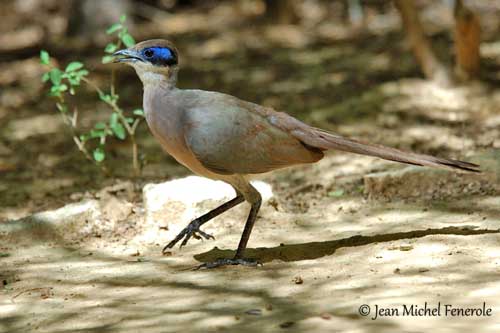
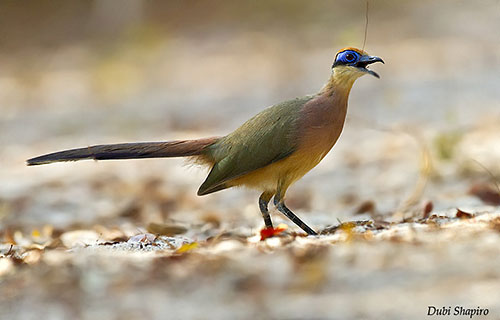
On the head, forehead and crown are rufous. We can see an area of blue bare skin around the eye, and a black line around this area, broader below and behind the eye, and forming a band on the nape.
The bill is black with blue-grey base. The eyes are dark brown to dark reddish-brown. Legs and feet are black.
Male and female are similar.
The juvenile is duller than adults with pale brown crown, and dark (not blue) bare skin behind the eye. Upperparts and wings are barred pale buff.
SUBSPECIES AND RANGE:
The Red-capped Coua has two subspecies. Races “ruficeps” and “olivaceiceps” are sometimes treated as separate species.
C.r. ruficeps (described above) is found in W Madagascar from Analalava W and S to Soalala near Morondava.
C.r. olivaceiceps is found in SW Madagascar, from Mangoky R, S to L Anony and W base of Anosyenne Mts.
This race is paler above and below than nominate. Forehead and crown are pale brown-green.
The upperparts are greyer olive-green with duller wings and scapulars.
On the underparts, the upper breast is lilac-grey, while the lower breast and flanks to undertail-coverts are cinnamon-buff.
The juvenile is duller with pale brown crown barred dark brown. The bare skin around the eye is dark and occurs only behind the eye. The upperparts are light brown with bronze-green gloss, barred black-brown and buff-white. The underparts are whitish with grey, barred brown, throat and breast.
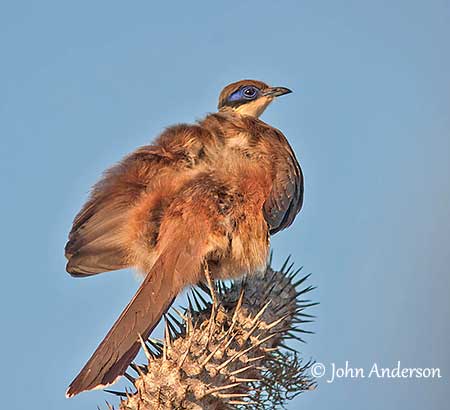
C.r. olivaceiceps
Spiny forest
HABITAT:
The Red-capped Coua of nominate race frequents dry deciduous forest, second growths, wooded savanna and gallery forest along rivers from sea-level to 350 metres.
The race “olivaceiceps” frequents spiny forest and transitional spiny bush and dry deciduous forest from sea-level to 900 metres of elevation.
Both races can be seen in degraded areas.
CALLS AND SONGS: SOUNDS BY XENO-CANTO
The Red-capped Coua gives loud “hug yew yew yew kuh kuh “with lower last notes. This series may descend in scale.
The song is a rapid “coy coy coy coy” usually given at dusk. We can also hear a rapid, ringing “quer-quer-quer-quee-quee”.
The race “olivaceiceps” gives a rapid “wu-kip-kip-kip-kip…” followed by lower and muffled-sounding “grou-grou-grou-grou-grou-grou”. Variations can be heard, described as loud, rising, high-pitched series of 5-20 notes rising and falling.
Varied calls include rattles and sounds made using the bill “brrrrrr”.
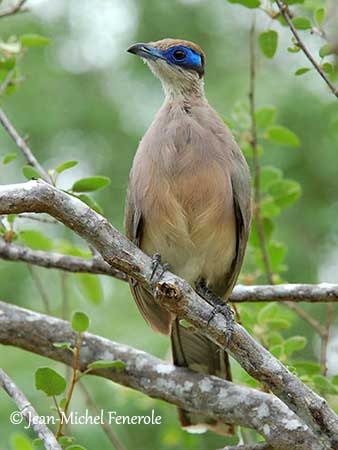
BEHAVIOUR IN THE WILD:
The Red-capped Coua feeds on large insects and also takes some fruits.
The nominate race feeds largely on arthropods and occasionally snails. During the dry season, it feeds more on plant matter, seeds, resin of Rhopalocarpus, and flowers of several plant species, but termites are reported too.
The race “olivaceiceps” feeds on large insects such as orthopterans, coleopterans, Blattodea, lepidopterans and ants.
They take the food items from both ground and bushes, foraging first in slow, direct gait and then, running very quickly once the prey is detected or if they are threatened. While running, wings or tail are open, probably to keep the balance. They may climb on low perches less than 1 metre high to sunbathe or call.
The Red-capped Coua can be aggressive towards a predator, flapping the wings at it, and pecking and scratching it while calling loudly.
They are primarily terrestrial birds, walking and running to escape a danger, and moving quickly in a jumping run. They frequently sunbathe.
The Red-capped Coua is seen alone, in pairs or in small family groups. It is territorial during the breeding season, and the breeding site fidelity is considerable. The same nesting area can be reused by the pair in several following years.
The courtship displays are poorly known, but the bright blue face pattern and the long, white-tipped tail are probably enhanced during the displays accompanied by calls.
The Red-capped Coua is resident with some seasonal variations within the W region for the nominate race.
The race “olivaceiceps” is resident and sedentary on the island.
Both races may take flight if alarmed, performing heavy glide of a few metres or flying over short-distance.
REPRODUCTION OF THIS SPECIES:
The breeding season occurs between October and January, with peak in November/December.
The Red-capped Coua builds a shallow, bowl-shaped structure in tree, between 2 and 6 metres above the ground, in the canopy or in the first fork of a tree, or in a bush. The nest is made with twigs, bark and thin lianas, and the cup is lined with softer materials.
The female lays 1-3 (usually 2) white eggs with dull blue tinge. Incubation period is unknown, but the chicks remain in the nest for 12 days. They are able to maintain upright begging posture as soon as the first day of their life. They have a bright-patterned palate.
The nests are vulnerable to predation by terrestrial predators because they are placed in open sites.
